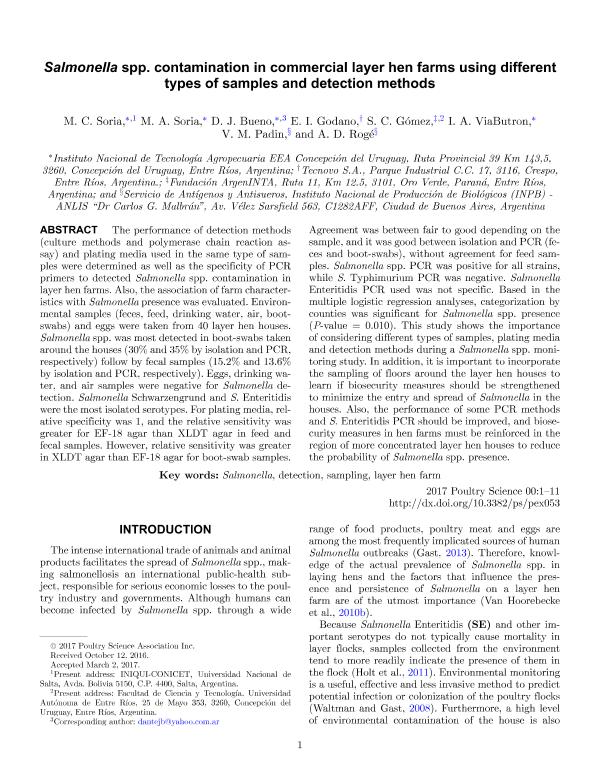Artículo
Salmonella spp. contamination in commercial layer hen farms using different types of samples and detection methods
Soria, María Cecilia ; Soria, María A.; Bueno, Dante Javier
; Soria, María A.; Bueno, Dante Javier ; Godano, E. I.; Gómez, S.C.; ViaButron, I. A.; Padin, V. M.; Rogé, A. D.
; Godano, E. I.; Gómez, S.C.; ViaButron, I. A.; Padin, V. M.; Rogé, A. D.
 ; Soria, María A.; Bueno, Dante Javier
; Soria, María A.; Bueno, Dante Javier ; Godano, E. I.; Gómez, S.C.; ViaButron, I. A.; Padin, V. M.; Rogé, A. D.
; Godano, E. I.; Gómez, S.C.; ViaButron, I. A.; Padin, V. M.; Rogé, A. D.
Fecha de publicación:
31/08/2017
Editorial:
Poultry Science Association
Revista:
Poultry Science
ISSN:
0032-5791
Idioma:
Inglés
Tipo de recurso:
Artículo publicado
Clasificación temática:
Resumen
The performance of detection methods (culture methods and polymerase chain reaction assay) and plating media used in the same type of samples were determined as well as the specificity of PCR primers to detected Salmonella spp. contamination in layer hen farms. Also, the association of farm characteristics with Salmonella presence was evaluated. Environmental samples (feces, feed, drinking water, air, bootswabs) and eggs were taken from 40 layer hen houses. Salmonella spp. was most detected in boot-swabs taken around the houses (30% and 35% by isolation and PCR, respectively) follow by fecal samples (15.2% and 13.6% by isolation and PCR, respectively). Eggs, drinking water, and air samples were negative for Salmonella detection. Salmonella Schwarzengrund and S. Enteritidis were the most isolated serotypes. For plating media, relative specificity was 1, and the relative sensitivity was greater for EF-18 agar than XLDT agar in feed and fecal samples. However, relative sensitivity was greater in XLDT agar than EF-18 agar for boot-swab samples. Agreement was between fair to good depending on the sample, and it was good between isolation and PCR (feces and boot-swabs), without agreement for feed samples. Salmonella spp. PCR was positive for all strains, while S. Typhimurium PCR was negative. Salmonella Enteritidis PCR used was not specific. Based in the multiple logistic regression analyses, categorization by counties was significant for Salmonella spp. presence (P-value = 0.010). This study shows the importance of considering different types of samples, plating media and detection methods during a Salmonella spp. monitoring study. In addition, it is important to incorporate the sampling of floors around the layer hen houses to learn if biosecurity measures should be strengthened to minimize the entry and spread of Salmonella in the houses. Also, the performance of some PCR methods and S. Enteritidis PCR should be improved, and biosecurity measures in hen farms must be reinforced in the region of more concentrated layer hen houses to reduce the probability of Salmonella spp. presence.
Palabras clave:
Detection
,
Layer Hen Farm
,
Salmonella
,
Sampling
Archivos asociados
Licencia
Identificadores
Colecciones
Articulos(INIQUI)
Articulos de INST.DE INVEST.PARA LA INDUSTRIA QUIMICA (I)
Articulos de INST.DE INVEST.PARA LA INDUSTRIA QUIMICA (I)
Citación
Soria, María Cecilia; Soria, María A.; Bueno, Dante Javier; Godano, E. I.; Gómez, S.C.; et al.; Salmonella spp. contamination in commercial layer hen farms using different types of samples and detection methods; Poultry Science Association; Poultry Science; 96; 8; 31-8-2017; 2820-2830
Compartir
Altmétricas



